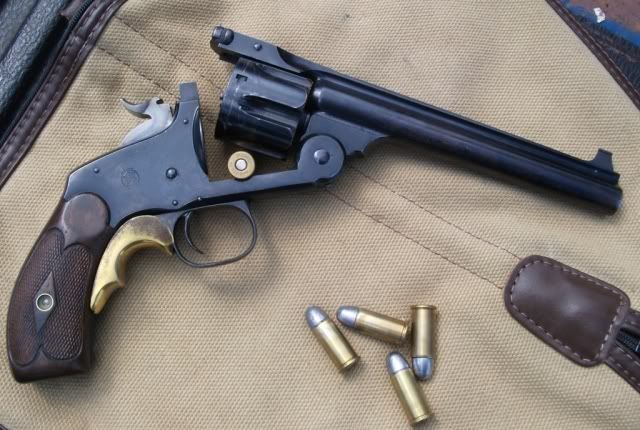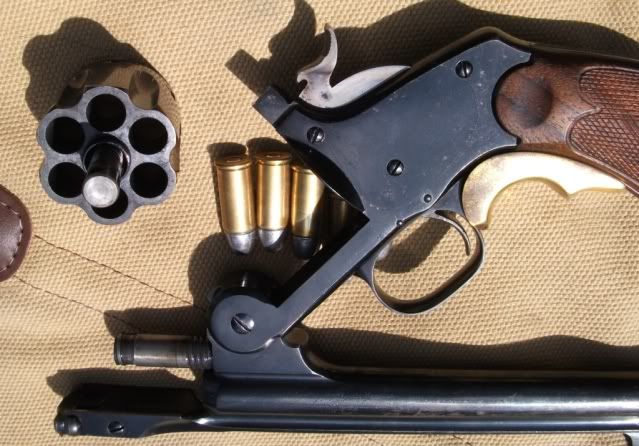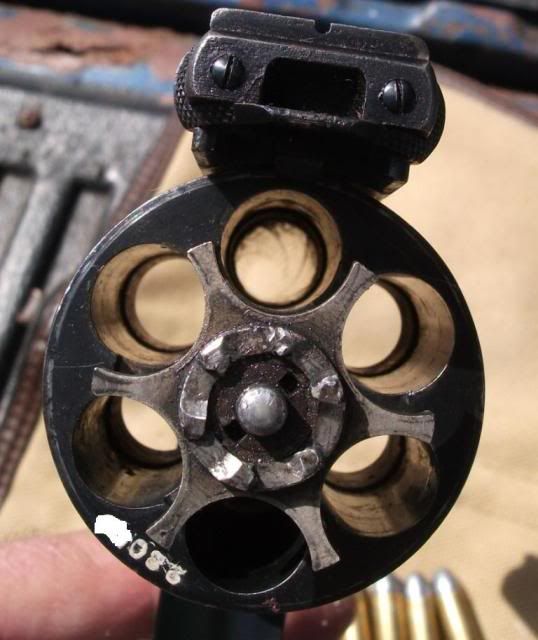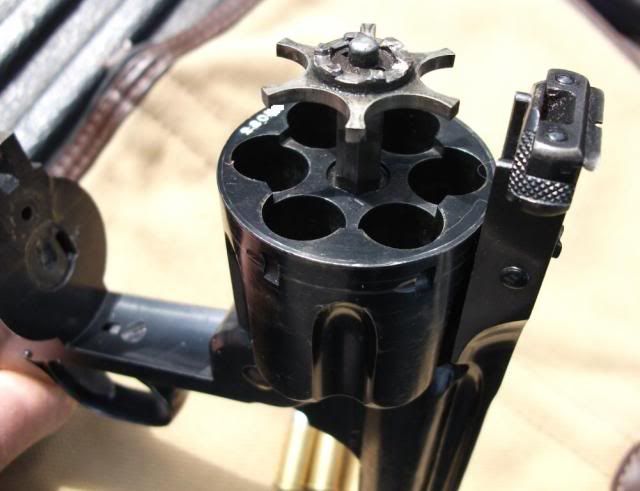You just explained why you had problems. Kids don't always know the right way of doing things at first. I won't go into all the things I did wrong as a kid. I don't think I have that much time left on earth. As for reloading partially loaded cylinders, I break the gun open so the shells come out about 1/4 inch. Then just grab the rim and pull them out. Still not a problem.
You are using an out of date browser. It may not display this or other websites correctly.
You should upgrade or use an alternative browser.
You should upgrade or use an alternative browser.
Break top revolvers? Questions regarding this design.
- Thread starter Kimio
- Start date
Let's talk about breaktop revolvers some more.
Someone makes a replica of an open-top Colt conversion/transitional revolver chambered in .38 Special. If someone can make that, why doesn't someone make a smaller caliber breaktop in at least .22 rimfire? Or has someone already? Replicas of a sort have been made of the Remingon double derringer in just about ever caliber but .41 rimfire, so why not a breaktop revolver?
And while we're on the subject, when did either Iver Johnson or H&R last make breaktop revolvers? Or any guns at all, for that matter?
Someone makes a replica of an open-top Colt conversion/transitional revolver chambered in .38 Special. If someone can make that, why doesn't someone make a smaller caliber breaktop in at least .22 rimfire? Or has someone already? Replicas of a sort have been made of the Remingon double derringer in just about ever caliber but .41 rimfire, so why not a breaktop revolver?
And while we're on the subject, when did either Iver Johnson or H&R last make breaktop revolvers? Or any guns at all, for that matter?
A bud brought this rare non rebounding hammer target Model in 44 Russian.
Top breaks are mechanically very weak, the latch will stretch under load. It is also very expensive to make.
Sure it can be faster to load than a standard double action revolver, but the speed does not offset the cost nor the tradeoff in lower pressure cartridges.






Top breaks are mechanically very weak, the latch will stretch under load. It is also very expensive to make.
Sure it can be faster to load than a standard double action revolver, but the speed does not offset the cost nor the tradeoff in lower pressure cartridges.






Bob Wright
New member
That is the first grip adapter I've ever seen on a top break!
Bob Wright
Bob Wright
Top-break revolvers have three primary disadvantages over solid-frame revolvers: they are not as strong, they are more difficult to engineer with complete extraction of longer cases, and they are more complex and expensive to manufacture.
As to strength, while they are weaker than solid-frame guns, they're historically more than adequate for the relatively low-powered cartridges they're chambered for. Cartridges like .22 Long Rifle, .38 S&W, and even .44 Russian and .455 Webley simply aren't all that hard on revolvers because they are low pressure and fairly mild-recoiling for the size guns they're usually put in.
Also, not all top-break revolvers are equal in strength. Probably the majority of top-breaks floating around today are small, inexpensive pocket guns from makers like Harrington & Richardson, Iver Johnson, Hopkins & Allen, Forehand & Wadsworth, and others. These guns, while still better than some of the cheap semi-autos like Jennings, Bryco, and Davis, were meant to be carried much more than fired and were not made with price being of higher concern than durability. The best quality top-breaks are probably the S&W's and replicas thereof and the higher-end British models like Pryse, Webley, and Enfield. The Webleys and Enfields in particular were probably the best and strongest top-breaks ever made. Not only were these guns made from better materials, but their stirrup-type latch is stronger and greatly superior to the more common eye-latch of most other top-break revolvers. If you wanted the most robust top-break available, the Webley Mk. VI would probably be the way to go.
The second issue is that a top-break is more difficult to design for complete extraction of longer cases like .38 Special and .44 Special, much less even longer cartridges like .357 and .44 Magnum. This is because the mechanism for automatic extraction must all be fit into a fairly confined space. With a solid-frame revolver, the only limiting factor as far as extraction is concerned is the length of the ejector rod and, therefore, the length of the barrel against which it lies.
Finally, a top-break is simply more complicated and expensive to manufacture. The top-break design, particularly one with automatic extraction, requires more complex machining and has more small, moving parts. This is why a Uberti Schofield replica costs several hundred dollars more than a comparable Single Action Army or Remington Model 1875/1892 replica does.
As to strength, while they are weaker than solid-frame guns, they're historically more than adequate for the relatively low-powered cartridges they're chambered for. Cartridges like .22 Long Rifle, .38 S&W, and even .44 Russian and .455 Webley simply aren't all that hard on revolvers because they are low pressure and fairly mild-recoiling for the size guns they're usually put in.
Also, not all top-break revolvers are equal in strength. Probably the majority of top-breaks floating around today are small, inexpensive pocket guns from makers like Harrington & Richardson, Iver Johnson, Hopkins & Allen, Forehand & Wadsworth, and others. These guns, while still better than some of the cheap semi-autos like Jennings, Bryco, and Davis, were meant to be carried much more than fired and were not made with price being of higher concern than durability. The best quality top-breaks are probably the S&W's and replicas thereof and the higher-end British models like Pryse, Webley, and Enfield. The Webleys and Enfields in particular were probably the best and strongest top-breaks ever made. Not only were these guns made from better materials, but their stirrup-type latch is stronger and greatly superior to the more common eye-latch of most other top-break revolvers. If you wanted the most robust top-break available, the Webley Mk. VI would probably be the way to go.
The second issue is that a top-break is more difficult to design for complete extraction of longer cases like .38 Special and .44 Special, much less even longer cartridges like .357 and .44 Magnum. This is because the mechanism for automatic extraction must all be fit into a fairly confined space. With a solid-frame revolver, the only limiting factor as far as extraction is concerned is the length of the ejector rod and, therefore, the length of the barrel against which it lies.
Finally, a top-break is simply more complicated and expensive to manufacture. The top-break design, particularly one with automatic extraction, requires more complex machining and has more small, moving parts. This is why a Uberti Schofield replica costs several hundred dollars more than a comparable Single Action Army or Remington Model 1875/1892 replica does.
